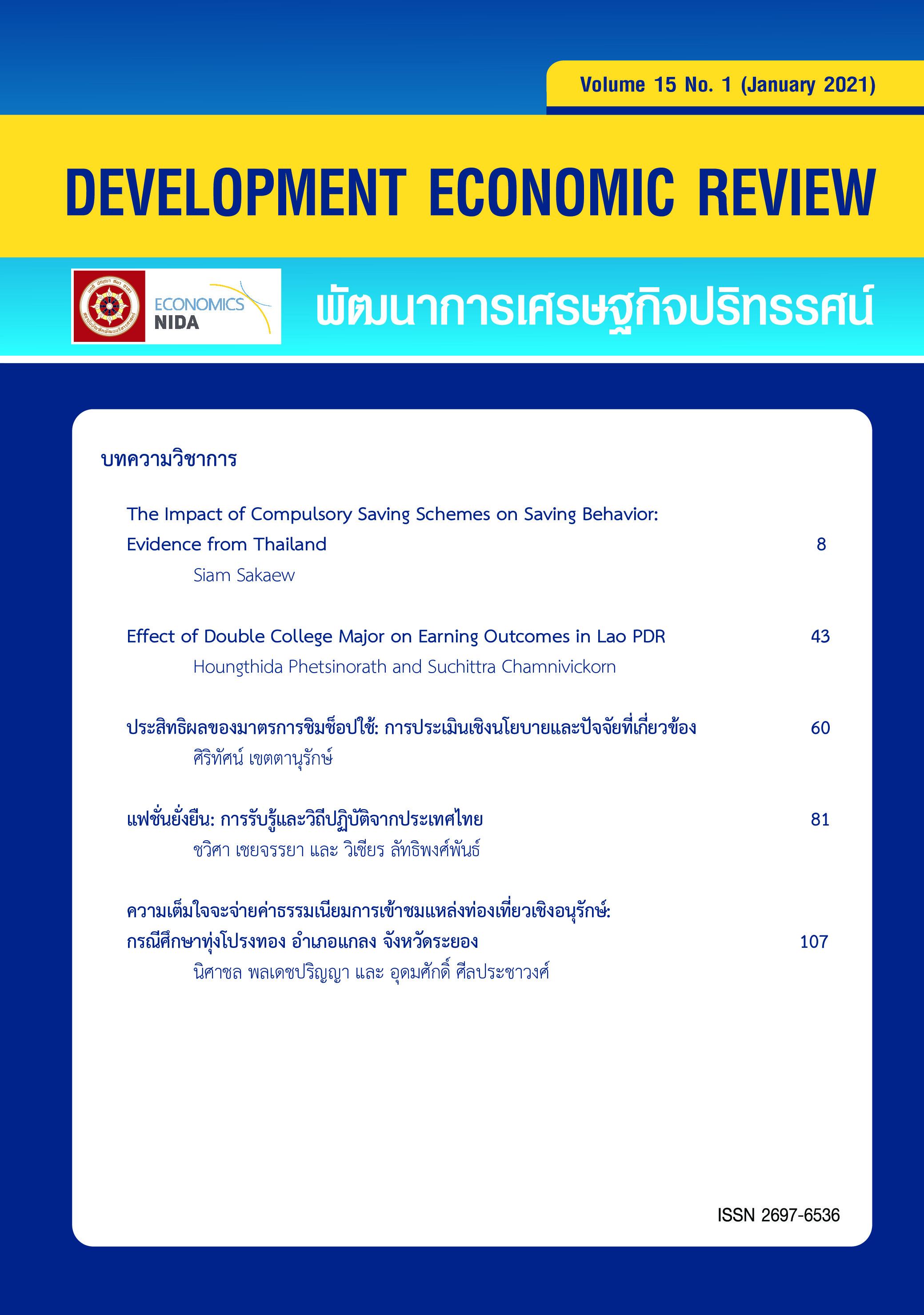Sustainable Fashion: Perception and Practice from Thailand
Keywords:
Sustainable Fashion, Design Thinking, Thai Practice, Sustainable Development, Supply ChainAbstract
Today, fashion Industry continues to thrive and inevitably affects economy, society and environment as a whole. Sustainable fashion is a phenomenon of creating balance among economic, social and environmental dimensions by shifting toward sustainable practice in fashion industry. This research aims to examine sustainable fashion knowledge and understanding among Thai people and to suggest practical guideline to embed sustainability as a new normal for Thai’s fashion practice. Researcher applies Design Thinking process on research framework. A quantitative approach was employed through a survey among 242 respondents. The finding indicates that 1) Thai people have inadequate knowledge and understanding toward sustainable fashion practice. 2) Buying intention has no correlation with buying quantity. 3) Knowledge and understanding toward sustainable fashion practice are correlated to the perception toward sustainable practice. 4) Perception toward sustainable practice has a negative correlation with buying quantity. 5) Perception toward downstream practice can predict the buying quantity. Furthermore, the researcher suggests a prototype as a practice guideline for all stakeholders to apply for a sustainable fashion in Thailand.
References
Camacho, M. (2016). David Kelley: From Design to Design Thinking at Stanford and IDEO. She Ji: The Journal of Design, Economics, and Innovation, 2(1), 88-101.
Claudia, E.H., Panayiota, J.A., & Caroline, J.O. (2016). What is Sustainable Fashion?, Journal of Fashion Marketing and Management: An International Journal, 20(4), 400-416.
Cochran, W.G. (1953). Sampling Techniques. New York: John Wiley & Sons. Inc. Ferraro, C., Sands, S., & Brace-Govan, J. (2016). The Role of Fashionability in Second-Hand Shopping Motivations. Journal of Retailing and Consumer Services, 32(2016): 262-268.
Fletcher, K. (2012). Sustainable Fashion and Textiles: Design Journeys. Sustainable Fashion and Textiles: Design Journeys, London: Routledge
Geiger, S.M., & Keller, J. (2017). Shopping for Clothes and Sensitivity to the Suffering of Others: The Role of Compassion and Values in Sustainable Fashion Consumption. Environment and Behavior, 50(10), 1119-1144.
Gurova, O. & Morozova, D. (2016). A Critical Approach to Sustainable Fashion: Practices of Clothing Designers in the Kallio Neighborhood of Helsinki. Journal of Consumer Culture, 18(3), 397-413.
Han, J., Seo, Y., & Ko, E. (2017). Staging Luxury Experiences for Understanding Sustainable Fashion Consumption: A Balance Theory Application. Journal of Business Research, 74(2017), 162-167.
Haug, A., & Busch, J. (2016). Towards an Ethical Fashion Framework. Fashion Theory, 20(3), 317-339.
Hur, E. (2016). Integrating Sustainability in Business Planning for Fashion Enterprises. In: 2016 International Textiles & Costume Culture Conference Proceedings. 2016 International Textiles & Costume Culture Conference, 30 Sep - 01 Oct 2016, Seoul, Korea. The Costume Culture Association.
IDEO. (n.d.). The Evolution of Design Thinking. Retrieved from https://designthinking.ideo.com/history.
Institute of Design at Stanford. (n.d.). An Introduction to Design Thinking Process Guide. Retrieved from https://dschool-old.stanford.edu/sandbox/groups/designresources/wiki/36873/attachments/74b3d/ModeGuideBOOTCAMP2010L.pdf.
Iran, S. & Schrader, U. (2017). Collaborative Fashion Consumption and Its Environmental Effects. Journal of Fashion Marketing and Management, 21(4), 468-482.
Jung, S. & Jin, B. (2014). A Theoretical Investigation of Slow Fashion: Sustainable Future of the Apparel Industry. International Journal of Consumer Studies, 38(5), 510-519.
Khunara, K., & Ricchetti, M. (2016). Two Decades of Sustainable Supply Chain Management in the Fashion Business: An Appraisal. Journal of Fashion Marketing and Management, 20(1), 89-104.
Khurana, K. & Ricchetti, M. (2016). Two decades of sustainable supply chain management in the fashion business, an appraisal. Journal of Fashion Marketing and Management, 20(1), 89-104.
Kolko, J. (2015). Design Thinking Comes of Age. Havard Business Review. Retrieved from https://hbr.org/2015/09/design-thinking-comes-of-age.
Machado, M.A.D., Almeida, S.O., Bollick, L.C., & Braganolo, G. (2019). Second Hand Fashion Market: Consumer Role in Circular Market. Journal of Fashion Marketing and Management. 23(3), 293-307.
Moorhouse, D. & Moorhouse, D. (2018). Designing a Sustainable Brand Strategy for the Fashion Industry. Clothing Cultures, 5(1), 7-18.
Niinimäki, K. (2013). Sustainable Fashion: New Approaches. Helsinki: Aalto ARTS Books, Pedersen, E.R.G. & Andersen, K.R. (2015). Sustainability Innovators and Anchor Draggers: A Global Expert Study on Sustainable Fashion. Journal of Fashion Marketing and Management. 19(3), 315-327.
Sachs, J., Schmidt-Traub, G., Kroll, C., Lafortune, G., & Fuller, G. (2019). Sustainable Development Report 2019: Transforming to Achieve Sustainable Development Goals. Retrieved https://unstats.un.org/sdgs/report/2019/The-Sustainable-Development-Goals-Report-2019.pdf.
Vehmas, K., Raudaskoski, A., Heikkila, P., Harlin, A., & Mensonen, A. (2018). Consumer Attitudes and Communication in Circular Fashion. Journal of Fashion Marketing and Management. 22(3), 286-300.

Downloads
Published
Issue
Section
License
Copyright to published manuscripts becomes the property of the Graduate School of Development Economics, National Institute of Development Administration. Reproduction of all or part of a Development Economic Review (DER) article by anyone, excluding author(s), is prohibited, unless receiving our permission.
Disclaimer: Opinions expressed in articles published in this journal are those of the author (s) and do nto necessarily represent opinions of the Graduate School of Development Economics, National Institute of Development Administration. Trade and proprietary names are only for identification and not constitute our endorsement.

